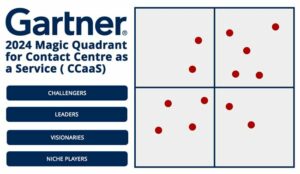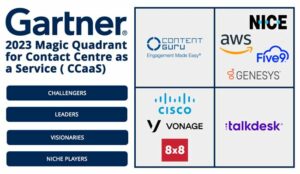Andrea Matsuda at NICE explains how contact centres can do more with less.
United States speed skater Apolo Anton Ohno trailed three competitors as he rounded the final turn of the men’s 1,500 short track at the 2010 Winter Olympics.
Heading into that turn, as momentum was shifting, visibility was poor, and the outcome uncertain, Ohno battled hard, forced two lead skaters to wipe out, and secured a second-place finish and his sixth Olympic medal.
Gartner calls this ability to accelerate performance during and following periods of high uncertainty “winning in the turns.” It refers to the business practices that balance strategic discipline with bold action on cost and talent management, just when the instinct to slow down is strongest.
The ”high uncertainty” ahead is beginning to come into focus as inflation reaches record levels in the United States and Europe. In October 2022 Europe broke its own historical personal record (PR) with a 10.7% inflation rate; the United States reached a new 40-year high in June 2022 with a 9.1% inflation rate.
Companies are also signaling rough winds ahead. E-commerce furniture company Wayfair announced in August 2022 that it will be laying off about 870 employees (roughly 5% of its payroll) and 10% of its corporate team.
The company joins tech giants such as Microsoft, Meta, Facebook, and Netflix that either slowed or froze hiring over summer 2022.
Contact centre leadership must lean on the lessons learned in the 2008 recession to prepare for what’s coming. However, Gartner points out how the coming recession is infused with two new pressure points that weren’t in play in 2008:
- Talent is scarce and expensive: 47% of CFOs report that it’s hard to hire talent, and of candidates who accepted a job in 2021, 49% had at least three other offers to consider.
- Global supply chains are still scrambled: 48% of CFOs believe that supply chain volatility and shortages will last beyond 2022, and supply chain issues are three times more likely to lead to customer disloyalty than price increases.
Let’s start with lessons learned. Gartner analysis reveals that very few companies—just 60 of the largest publicly traded companies in the United States and Europe—ended up as winners after the recession that ended in mid-2009. Moreover, those 60 companies sustained their dominant performance over the subsequent decade.
The analysis went on to define the two things those 60 companies did differently:
- They committed before the turn to the differentiating elements of their strategy, including talent strategy, to position themselves to power through uncertain times, not simply respond to them.
- They effectively balanced top- and bottom-line growth across business conditions. By contrast, Gartner research shows that focusing only on cost-cutting has historically come at the expense of top-line growth.
So how do contact centre leaders apply these learnings and power through the turns? It starts with doing more with digital, even if that means investing in tools and software when cost-cutting is most tempting.
And it starts with an honest inventory of the current state of your staffing landscape and the capabilities needed to push you across the finish line.
Ask yourself these questions:
How Does My Mix of Agent Skill Sets Need to Change?
With supply chain issues already putting stress on the customer experience, contact centres must be prepared to provide instant, intuitive, smart support when and where customers need it.
Omnichannel service across phone, chat, email, and social media provides that on-demand support but creates scheduling challenges in a contact centre.
After all, not all agents are created equal. An agent that is a master over the phone might struggle with typing on chat. One agent may be able to handle three chats at once with ease; another may struggle with more than one.
How Does Our Technology Help Agents Do More With Less Staff?
Channels such as chat, social media, and text messaging are best executed through a series of transactions that may not necessarily be sequential or contiguous.
There are often delays between responses to digital interactions, and this noncontiguous, nonsequential workflow complicates contact centre scheduling.
Traditional WFM processes focus on inbound queues, which logically follows the assumption of sequential and contiguous work streams. A contact centre agent handles the first call in queue from the beginning to the end and then moves on to the next call once the first call is completed.
However, with digital channels agents can—and should, as the value of doing more with less is at a premium—handle more than one customer interaction simultaneously.
Heading into the turn, contact centres should seek WFM solutions flexible enough to offer choices that enable businesses to decide on the right approach while providing ways to address the characteristics of a digital channel and offering ways to accurately forecast and schedule in a multiskill and multichannel environment.
It’s about doing more with less now and preparing to sprint when market conditions shift into the black. Today’s contact centres are far more resilient than they were before the recession that ended in 2009. They have survived a global pandemic and the “great resignation.”
Powered with the right technology, contact centres can optimize the market challenges ahead to win in the turn.
This blog post has been re-published by kind permission of NiCE-ltd – View the Original Article
For more information about NiCE-ltd - visit the NiCE-ltd Website
Call Centre Helper is not responsible for the content of these guest blog posts. The opinions expressed in this article are those of the author, and do not necessarily reflect those of Call Centre Helper.
Author: NiCE-ltd
Published On: 16th Jan 2023 - Last modified: 6th Sep 2024
Read more about - Guest Blogs, Andrea Matsuda, NiCE






 NiCE (NASDAQ: NICE) is transforming the world with AI that puts people first. Our purpose-built AI-powered platforms automate engagements into proactive, safe, intelligent actions, empowering individuals and organizations to innovate and act, from interaction to resolution. Trusted by organizations throughout 150+ countries worldwide, NiCE’s platforms are widely adopted across industries connecting people, systems, and workflows to work smarter at scale, elevating performance across the organization, delivering proven measurable outcomes.
NiCE (NASDAQ: NICE) is transforming the world with AI that puts people first. Our purpose-built AI-powered platforms automate engagements into proactive, safe, intelligent actions, empowering individuals and organizations to innovate and act, from interaction to resolution. Trusted by organizations throughout 150+ countries worldwide, NiCE’s platforms are widely adopted across industries connecting people, systems, and workflows to work smarter at scale, elevating performance across the organization, delivering proven measurable outcomes. 









